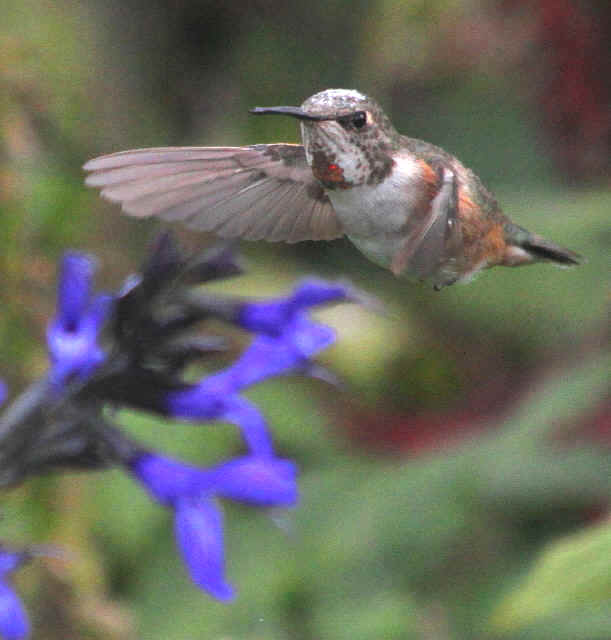Many of us are looking forward to the CBCs
(Christmas Bird Counts) this upcoming winter.
This past week, we received in the mail the 111th
Christmas Bird Count publication from the National
Audubon Society.
In it, there's a summary of the counts that were
conducted last December and January, during which thousands of
people participated throughout North America and elsewhere. I participated
in two of them, one in Pennsylvania and one in Delaware.
Looking through the publication, I found a number of interesting things, some
that I did not know. Here, some of these will be shared
with you, but first, some notable bird sightings from this
past week or so, in the northeast US:
A MAGNIFICENT FRIGATEBIRD was seen last week at Nantucket
Island, Massachusetts. MAGNIFICENT
FRIGATEBIRDS nest in only one US state, Florida.
Seen at Nantucket since then have been SCISSOR-TAILED FLYCATCHER
and TOWNSEND'S SOLITAIRE, both birds from further west.
Most SCISSOR-TAILED FLYCATCHERS migrate south to
Central America for the winter. The TOWNSEND'S SOLITAIRE winters
mainly in the western United States.
There was also a SCISSOR-TAILED FLYCATCHER on Long Island, New
York, at the Captree Park on October 22.
Also on Long Island, recently, a GRAY KINGBIRD was at Jones
Beach the morning of October 15. A WESTERN KINGBIRD was
also seen there, later that day. GRAY KINGBIRDS are mostly
on Caribbean islands.
A dark SWAINSON'S
HAWK was seen at Cape May Point, New Jersey,
on October 21 & 22. Another SWAINSON'S HAWK was observed
in New Jersey, on October 24, at the Brigantine National
Wildlife Refuge.
Many SWAINSON'S HAWKS winter in Argentina, but not all.
A FRANKLIN'S GULL was found in western Pennsylvania
at the Moraine State Park on October 21.
A SABINE'S GULL was in a parking lot in Wells, Maine
on October 19.
Both the FRANKLIN'S and the SABINE'S GULLS winter mostly at
sea in the Southern Hemisphere.
A SPOTTED TOWHEE (a bird normally in the western US) was
spotted in New Jersey at the Liberty State
Park on October 22 only.
A TUFTED DUCK (mostly a Eurasian bird) has recently been found
in Attleboro, Massachusetts.
An ANHINGA was reported in the sky over Chester County, Pennsylvania, the
morning of October 24.
A SELASPHORUS HUMMINGBIRD (from western North America)
was seen in Pennsylvania, near Little Gap, on October 21.
A non-bird note: NORTHERN LIGHTS were seen in the sky last
night over Pennsylvania, Michigan,
and even south to the Southern US.
Now, the interesting items, as promised, from the Bird
Counts last winter. Some of which, as I noted, I did not know
prior to reading the publication just distributed. If
there's something here, one thing or more, that you may
not have known, or that you found particularly
interesting, please send us an e-mail, if you would, and
let us know that.
It was stated in the first paragraph that thousands of people
participated last winter in the annual Christmas Bird Counts.
Also, thousands of birds were counted. And hundreds of
species.
4 of the "top counts", with more
than 150 species were in Texas. 5 were in California.
But, referring here to Texas, there were:
Matagorda County (the top count in North
America, with 236 species)
Guadelupe River Delta (the second highest
count in North America, with 222 species)
Freeport (206 species)
San Bernard National Wildlife Refuge (193
species)
Some of the more-rare bird species found during Counts in Texas
included:
a BLACK-VENTED ORIOLE and a BLUE BUNTING at Anzalduas-Bentsen,
a VIOLET-CROWNED HUMMINGBIRD at Davis Mountains,
a NORTHERN TUFTED FLYCATHCER at Big Bend,
a GREATER PEWEE at Santa Ana,
a WHITE-THROATED THRUSH at Welaco,
a RUFOUS-BACKED ROBIN at Laguna Atacosa,
and CRIMSON-COLLARED GROSBEAKS at Corpus Christi and Weslaco.
The BLACK-VENTED ORIOLE is extremely rare in Texas, the bird
was the first during a CBC (Christmas Bird
Count) anywhere in the US.
The NORTHERN TUFTED FLYCATCHER was first found on
November 23, and continued until the Count.
During the CBCs along the coast of the Gulf of
Mexico, from Texas east to Florida,
the most numerous bird, from 1965 to 2011, has been the
RED-WINGED BLACKBIRD.
The 10 bird species whose populations have increased
the most in that Gulf Coast Region, during that time,
have been:
BLACK-BELLIED WHISTING DUCK, ROSS'S GOOSE, GLOSSY IBIS,
BLACK-NECKED STILT, OSPREY, NORTHERN GANNET, HOODED MERGANSER,
ROSEATE SPOONBILL, WHITE IBIS, WHITE-FACED IBIS (as you
noted, 3 species of IBIS).
The 10 bird species whose populations have decreased
the most in that Gulf Coast Region, during that time,
have been:
CANADA GOOSE, EARED GREBE, CANVASBACK, AMERICAN WIGEON,
WILSON'S PLOVER, NORTHERN PINTAIL, KING RAIL, RED-BREASTED
MERGANSER, HERRING GULL.
Number #11, by the way, is the RED-WINGED BLACKBIRD, which is
still, as noted, the most numerous bird there in the winter.
Whereas there are many birds in the winter in Texas, in Alaska
there are not. But an interesting item nonetheless:
Back in 1974, the EURASIAN COLLARED DOVE was introduced
accidentally in the Bahama Islands, and it soon spread to
Florida. And since then, it has continued to spread.
Yes, even to Alaska, where there has been an
explosion of EURASIAN COLLARED DOVES. It was found on a
CBC in Alaska 2 years ago for the first time, but
last winter a total of 41 were observed on 6 Counts. At
Glacier Bay, Skagway, Juneau, Ketchikan, Mitkof Island, and
Cordova.
As an aside here, as an item of interest, not during a CBC,
but prior to it, and not last year, but 4 years earlier,
there was a remarkable bird occurrence in British
Columbia, when a COOK'S PETREL landed within the
count circle for Lillooet. It was a first record for
Canada, and a significant inland occurrence for North
America.
Found on December 7, 2007, the bird appeared after a very
intense southwest storm, known as the "Pineapple Express".
Sadly, it died 2 days after its discovery (and about 3
weeks prior to the CBC).
Now, after that quick intermission ("did you
know?"), back to the continuation of our summary of birds
from last winter's counts:
On the other side of North America, in eastern
Canada, the weather during the fall of 2010
apparently brought a number of NORTHERN LAPWINGS across the
North Atlantic. The species is a rare vagrant to North
America. 3 lingered to be tallied on CBCs in the Atlantic
Provinces. A pair of NORTHERN LAPWINGS was seen flying
south at Antigonish, Nova Scotia, on December 19, 2010.
Oddly, another related shorebird that normally goes south of
Atlantic Canada in the winter is the KILLDEER. Small
numbers began to appear along the southern coasts of Newfoundland
and Nova Scotia in December 2010. The species
was then found on Counts in Newfoundland at Ferryland and Cape
Race, and in Nova Scotia at Halifax-Dartsmouth, Sheet Harbor,
and Glace Bay.
One KILLDEER, during this odd occurrence, even made its way
across the North Atlantic, east to the United Kingdom.
A first for a CBC in Canada was a
BLACK-TAILED GULL in St. John's, Newfoundland.
The BLACK-TAILED GULL is sometimes called the "JAPANESE
GULL" as nearly all of the breeding of that species
occurs in Japan.
If you've ever looked at a map at the islands of Saint-Pierre
and Miquelon in the North Atlantic, and wondered what
might be there during a Christmas Bird Count, these birds
were:
14 hardy RED KNOTS on Miquelon Island,
a winter population of 522 WHITE-WINGED SCOTERS (that was more
than anywhere in Atlantic Canada),
and 63 BOREAL CHICKADEES.
Although in the North Atlantic, off Canada, the islands
of Saint-Pierre and Miquelon are a piece of France.
In Quebec, at the tip of the Gaspe Peninsula,
there was an ANNA'S HUMMINGBIRD at Perce, that appeared in
October and stayed until December 24.
Another ANNA'S HUMMINGBIRD spent the winter in Pennsylvania, near
Shartlesville.
Incredible, both birds, as the species is normally in the
winter in the warm American Southwest.
Also from the West, an ALLEN'S HUMMINGBIRD was during a CBC in
Northampton, Massachusetts, a MOUNTAIN
BLUEBIRD in New Bedford, Massachusetts, and a
GREEN-TAILED TOWHEE was in Newport County/Westport,
Massachusetts/Rhode Island.
In upstate New York, there was a long-staying
LEWIS'S WOODPECKER during the CBC for Conesus-Hemlock-Honeoye
Lakes.
Downstate in New York, a VARIED THRUSH wintered in Central
Park, Manhattan, New York City. It was there for the Lower
Hudson CBC.
In Pennsylvania, there was a tally of 357
LESSER BLACK-BACKED GULLS in Southern Bucks County, where
there was also a female RUFOUS HUMMINGBIRD in Yardley, that
had been present since October.
In Berks County, Pennsylvania, there was a YELLOW-THROATED
WARBLER at Blue Marsh.
Not Blue Mash, as in Maryland, but in that
state there was a GOLDEN-CROWNED SPARROW in Lower Kent
County.
A CALLIOPE HUMMINGBIRD at Tryon, North Carolina,
was a new species for a CBC in that state.
Also interesting was a total of 83 RUBY-THROATED HUMMINGBIRDS
during Counts along the North Carolina Coast.
In Arkansas, a BARNACLE GOOSE at Pine Bluff
was a first state record.
In California, a WOOD STORK was there for the
Escondido Count, present for its 22nd season. Now that's a
longevity record of sorts for a single bird.
Back now from the Pacific to the Atlantic, well into the
Atlantic:
Bermuda invariably sports a list of
"unusual birds". Last year, it did again with:
BROWN CREEPER, RUBY-THROATED HUMMINGBIRD, and YELLOW-BILLED
CUCKOO. And, from more-northerly lands, in Bermuda as
well were LAPLAND LONGSPUR and COMMON REDPOLL.
In the Caribbean, there was a new Winter Bird
Count this past year, in Haiti, at
a place called Les Cayes - the
place where J.J. Audubon was born. It's only fitting that an
Audubon Society Bird Count be conducted there!
Again, if there's been anything in this summation that's been
either new or especially interesting to you, please let me
know. I'd be glad to hear from you.
Armas Hill has presented the Birdline,
originally from Philadelphia, on the phone and internet for
decades (3), and on the radio in Delaware for years (10).
The Birdline (and the Natureline)
are affiliates of Focus On Nature Tours.
A Christmas Count in the Caribbean was mentioned in the
preceding text. Upcoming Focus On Nature Tours to
the Caribbean, for birds & other nature, are scheduled for
the months when winter will be with us in North America:
In the Cayman Islands and Jamaica,
November 30-December 3, 2011
In Puerto Rico, January
22-27, 2012
In the Dominican Republic, January
28-February 4, 2012
and in the Lesser Antillean islands
of Barbuda, Montserrat, Guadeloupe, and Dominica,
February 4-12, 2012.
Information about these tours & others can be found in
the FONT website: www.focusonnature.com


